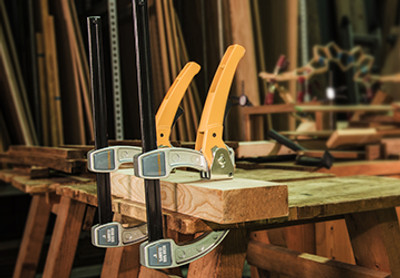Workshop Clamps – A Guide for Beginners
POWERTEC on Mar 9th 2021
How many clamps do you need in your workshop? For many of us, the answer to this is simply “more”. In this blog issue, we’re looking at clamping essentials that you’ll need for your workshop. With the right clamps at hand, almost anything is possible.
Pipe Clamps are simply clamp heads attached to a length of pipe. They can be used for both clamping or spreading, and are often employed in cabinet making and edge gluing. These are incredibly versatile clamps as the jaw length is limited only by the length of the pipe being used. Pipe clamps are often seen as cost-effective substitutes for both bar and parallel clamps. This allows new woodworkers to delay spending a fortune on specialized clamps until they’re sure they need them.
Bar Clamps are clamps designed with sliding heads making them easy to open and adjust to the project at hand. Popular styles of bar clamp include:
(A) Heavy-Duty F-Style Clamps: These are true workshop essentials. If you were to have any clamps in your workshop, it would be a few sets of these as applying even pressure (when gluing for example) requires evenly spacing clamps along the length of the project.
(B) Ratcheting Bar Clamps: These come in a variety of sizes: 6”, 12”, 24”, 36”, up to 42”. Like classic F-clamps, these clamps are very easy to setup. The quick-release mechanism frees the lower end of the clamp allowing it to be properly positioned. The clamp is then tightened around the workpiece by squeezing the handle. Once locked, this clamp is secure.
(C) Gear Bar Clamps: These are another type of F-style ratcheting clamp. This is a heavy-duty clamp specifically designed for smaller projects.
Parallel Clamps are high performance (and high priced) clamps that can apply incredible clamping force and allow for large opening capacity. A key feature of these clamps are the jaws which remain parallel under pressure. The wide mouth and high clamping pressure make them ideal for projects such as doors and tables. In addition, the head can be reversed, turning the clamp into a spreader.
Universal Fence Clamps are compact clamps used to secure auxiliary fences and stops to an existing fence. Secured into a 3/8” hole, this type of clamp is often used with table saws, miter saws and router tables – anywhere that you need a clamp, yet want to keep the clamp out of your way.
Spring Clamps are convenient little clamps that act like an extra hand; the strong jaws hold pieces together tightly and are great for gluing down small parts and for minor repairs, such replacing chipped veneer. These clamps work via a spring mechanism, much like a big clothes peg. Spring clamps are a workshop essential that you’ll always find new uses for.
Band/Strap Clamps are the clamps you use to hold together irregular shapes such as picture frames and boxes. The band is extended and surrounds the project being worked on. The corner braces are placed at each joint, the strap is then tightened and locked. On turning the handle, further pressure is applied, securing the workpiece and locking it.
Wooden Hand Screw Clamps may look like they belong in a museum, but there are good reasons most clamp venders still produce this style of clamp, including: they can be used to clamp irregular or tapered workpieces (unlike other clamps), they can also help with assembly, keeping panels upright, and being made of wood, the clamp surface won’t mar your workpieces.





